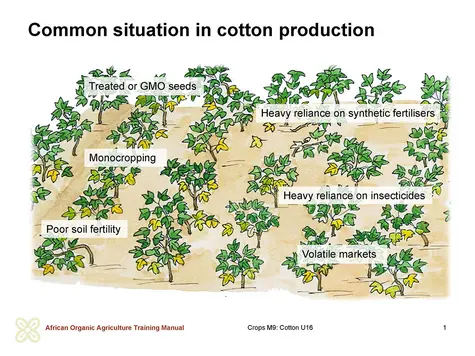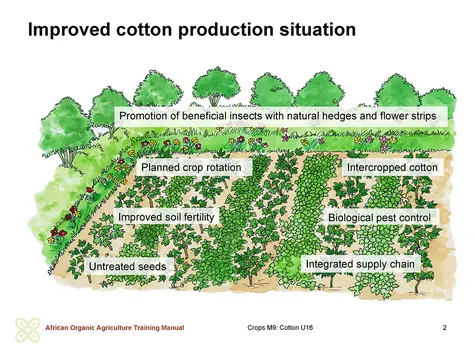Introduction
Cotton (Gossypium spp.) is a very important fibre crop and plays a major role in the economies of several Central and West African countries. Tanzania leads organic cotton production in sub-Saharan Africa, but only contributes about 2 % to the global organic cotton production. Other relevant African organic cotton countries are Uganda, Mali, Burkina Faso, Benin, Senegal, South Africa, Zambia, Togo, Kenya and recently in Ethiopia.
Organic cotton is grown on farms of a few acres to 50 or more acres in mostly diverse farm systems with often integrated animal husbandry and usually not more than half of the arable area under cotton.
The African organic cotton sector is rather young, but has several initiatives by non-governmental organisations and by pioneers in the private sector searching for niche markets. This market has been assured by wealthier and environmentally conscious consumers from industrialized countries. Today demand is higher than supply. Shortage in supply is essentially caused by the complexity and the many risks and challenges that are related to the organic cotton production process.
Common challenges to cotton production in Africa
- Limited access to good quality seeds - National cotton regulatory bodies ensure the distribution of cotton seeds, mostly hybrids, closely linked to seed companies which nearly control the entire cotton seed sector. The producers can hardly participate in the breeding process without having access to the parent lines. Breeding of varieties specifically suitable for sustainable agriculture remains a big challenge all over Africa.
- Heavy reliance on insecticides - Cotton production is dominated by monocropping systems and consumes about 19 % of all insecticides used in agriculture worldwide. The pesticides are often provided within credit and extension schemes, where farmers are expected to pay back after harvest. Due to the complexities of cotton production, sometimes there is hardly enough harvest for the individual farmer to pay back for the inputs as well as meet personal needs. The high costs as well as the health risks, for example for pregnant women, are key arguments for farmers not to use synthetic insecticides.
- Decreasing soil fertility - Many conventional cotton farmers in the South are in a crisis due to decreasing soil fertility. With prices for mineral fertilizers increasing and the continuous need to produce enough cereals for household consumption, a growing number of farmers started using the fertilizer designed for cotton on their food crop fields, therefore, fertilizer is no longer available for the cotton fields.
- Increasing production costs - Costs for nitrogen fertilizers, chemical pesticides, irrigation and labour have all increased in the last years. If this factor is matched by low cotton prices on the markets, then the cotton producers hardly make any profit. Unstable cotton prices are very common, as they react to small changes on the global market.
- Volatile markets - The high price fluctuations can lead to important economic losses, particularly if the market information is not available in a timely manner. In 2008, the oversupply of organic cotton led to very low prices for organic cotton. In 2011, the situation had reversed, leading to an increase in supply. The domestic market hardly exists in Africa, so most produce is exported.
- In view of the prevalent challenges, an increasing number of farmers turn to organic cultivation in order to restore soil fertility, reduce production costs and/or to get a better price for their certified organic harvest. This chapter introduces organic approaches to be adapted to local conditions in order to ensure a sustainable and profitable production of cotton.


 tap and then scroll down to the Add to Home Screen command.
tap and then scroll down to the Add to Home Screen command.